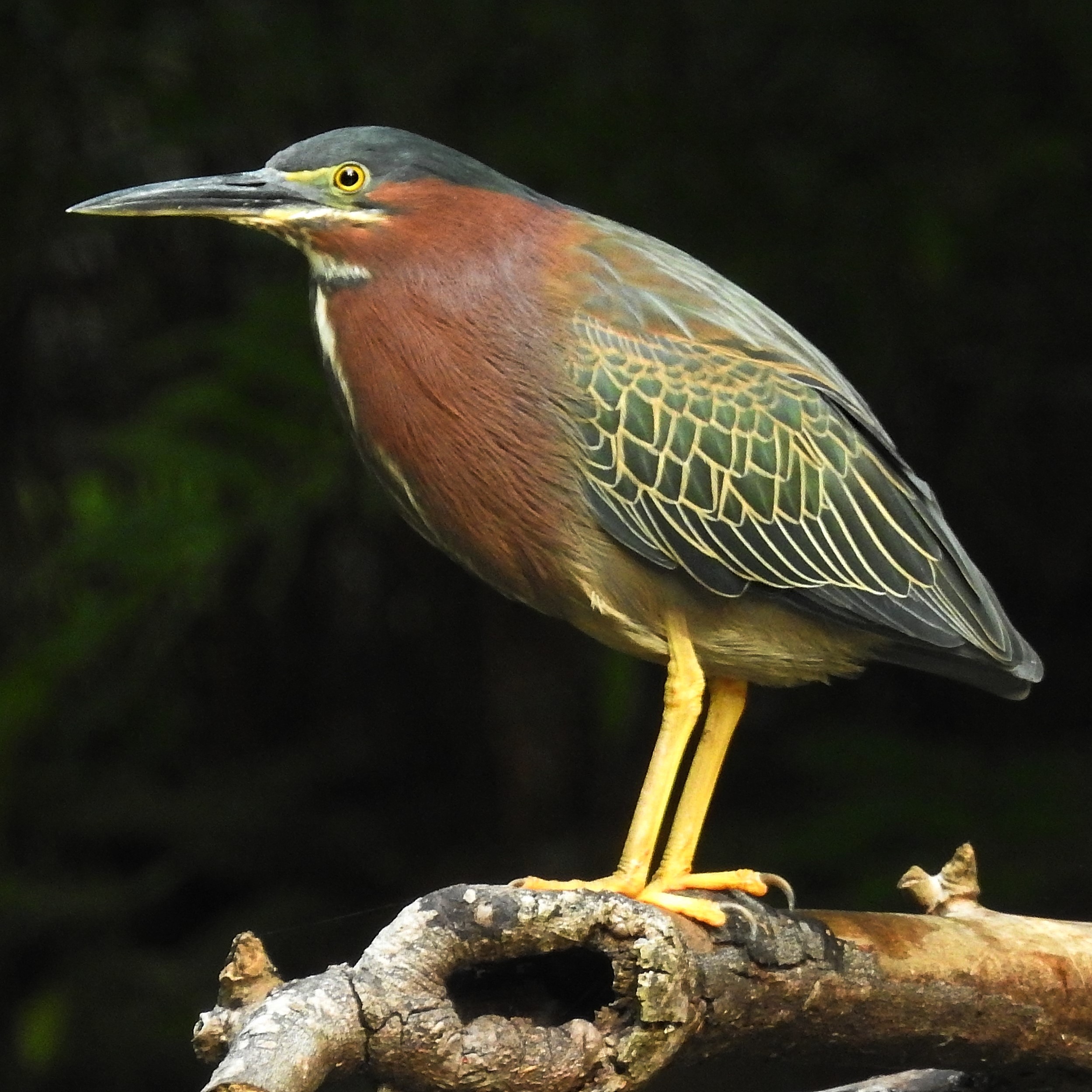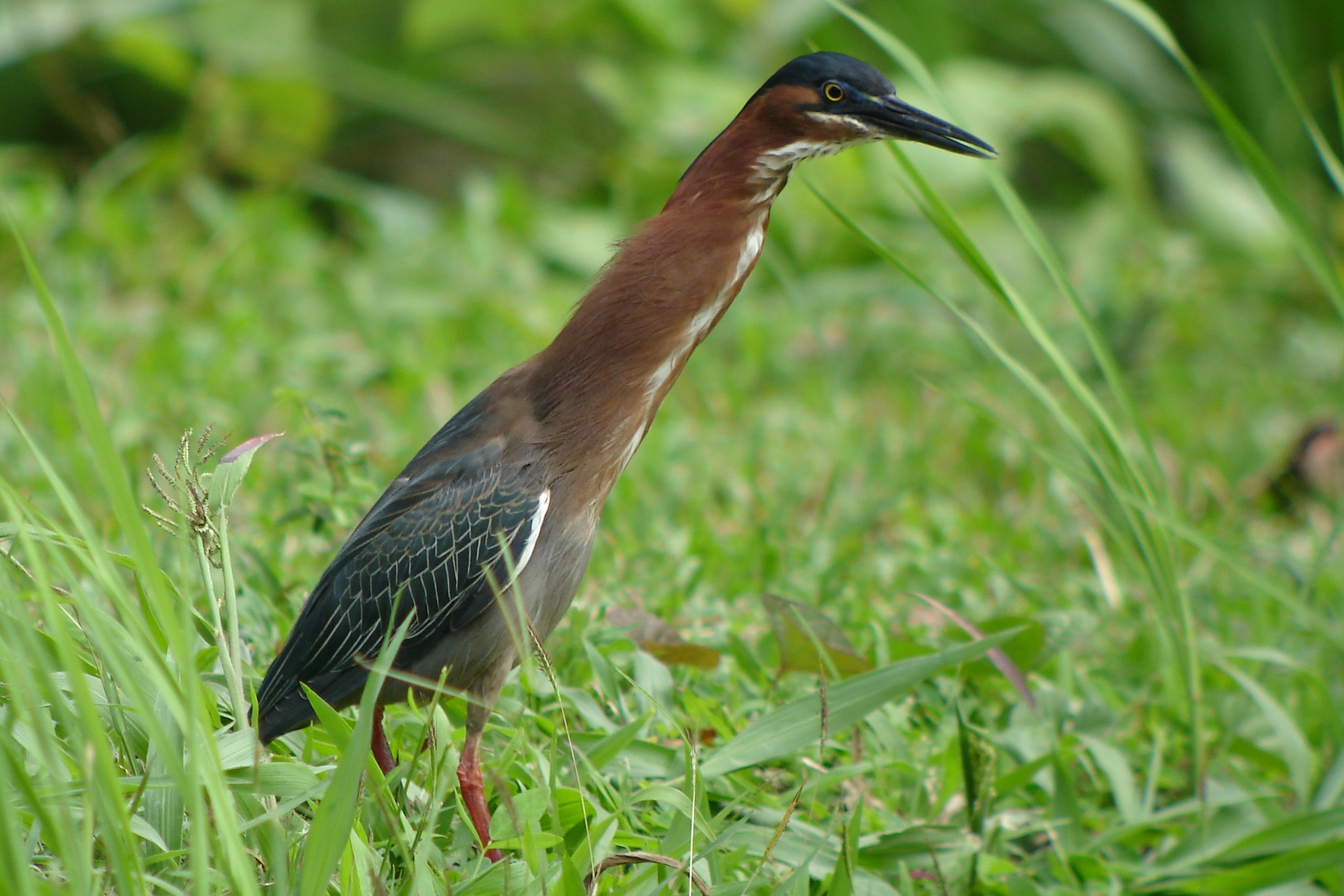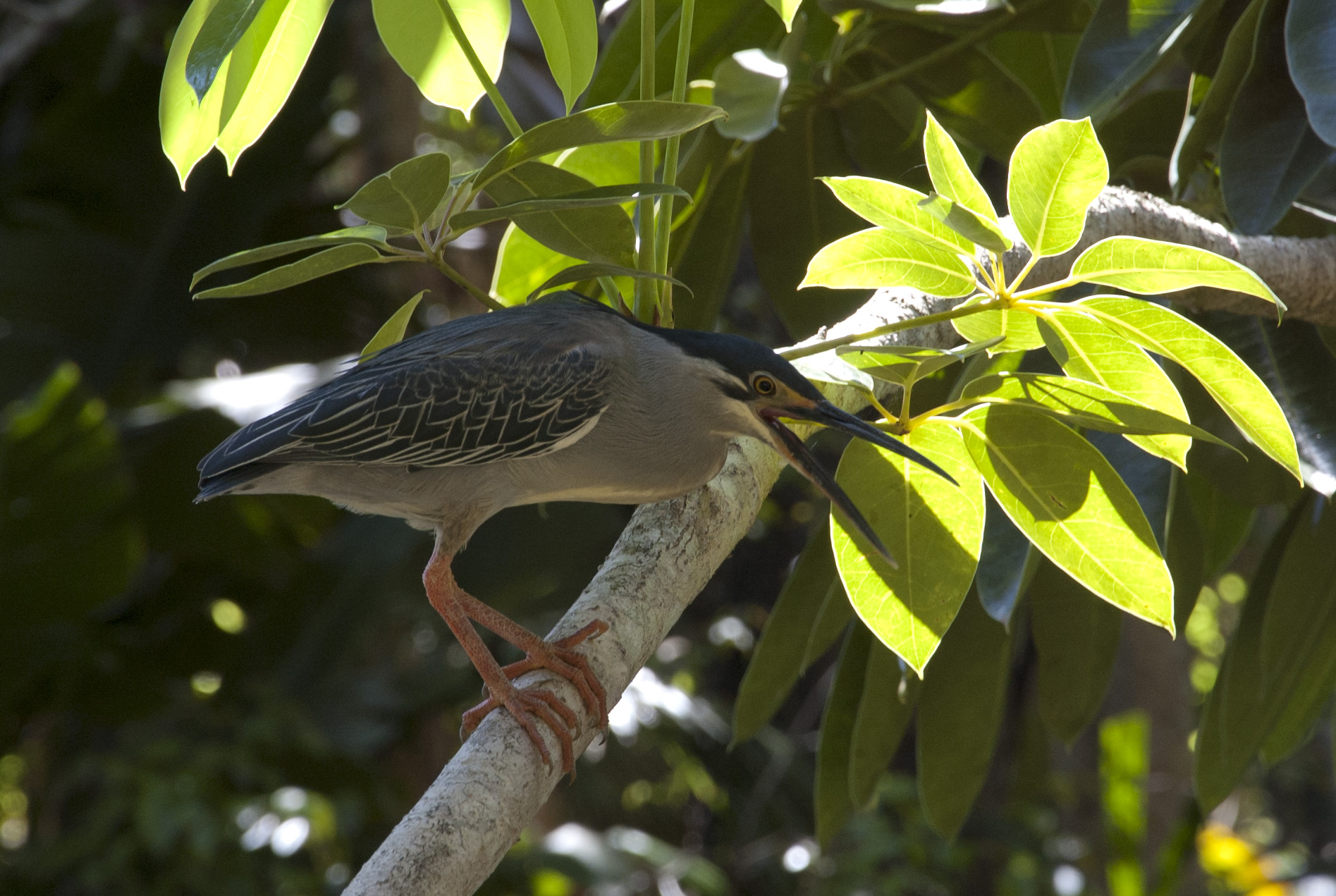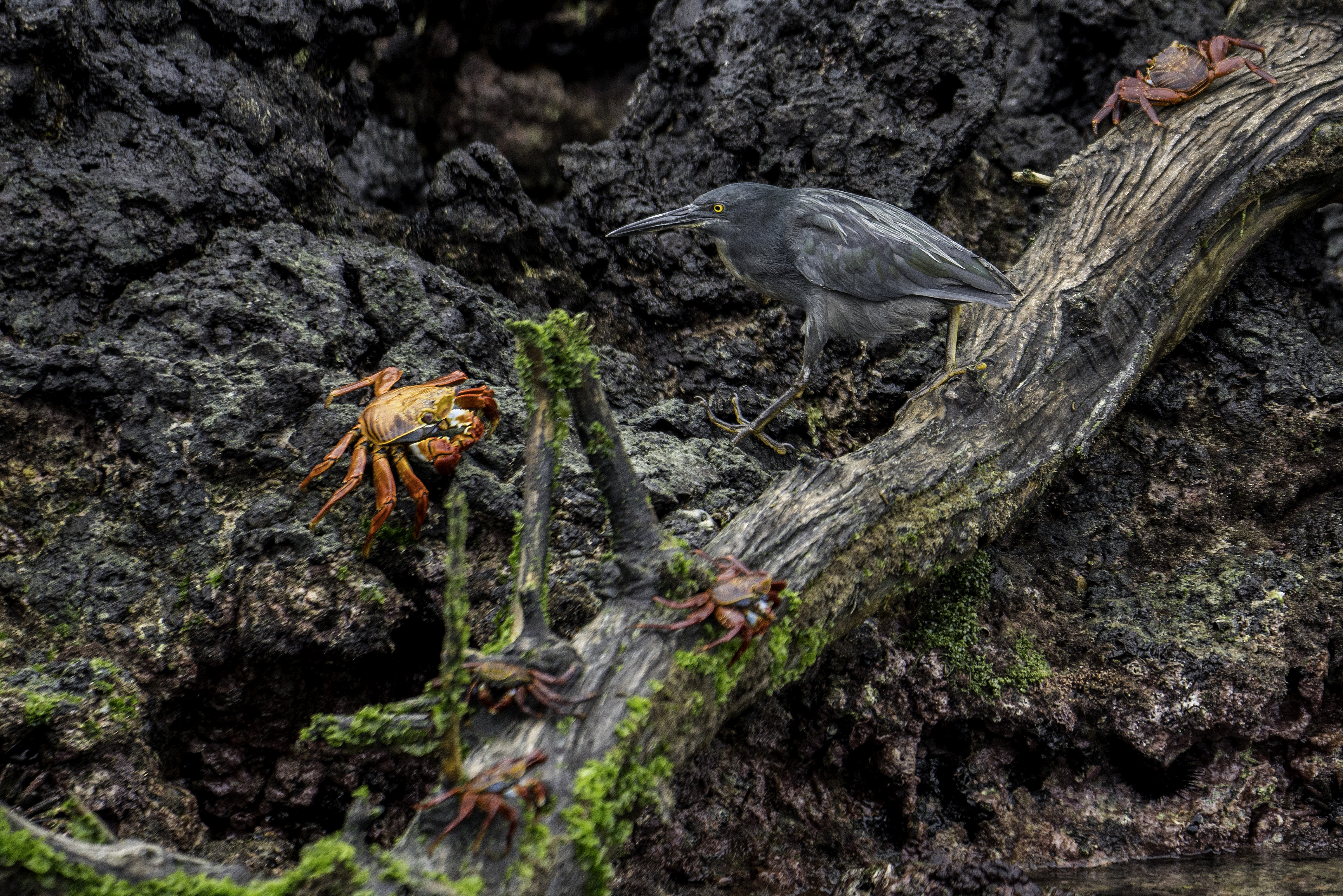|
Butorides
''Butorides'' is a genus of small herons. It contains three similar species, the green heron or green-backed heron, ''Butorides virescens'', the lava heron (''Butorides sundevalli''), and the striated heron, ''Butorides striatus''. A fossil species, ''Butorides validipes'', is known from the Early Pleistocene of Florida in the United States. ''Butorides'' is from Middle English ''Butor'' "bittern" and Ancient Greek ''-oides'', "resembling". Adults of both extant species are about long, and have a blue-black back and wings, a black cap and short yellow legs. Juveniles are browner above and streaked below, and have greenish-yellow legs. The species have different underpart colours, chestnut with a white line down the front in green heron, and white or grey in striated. Both breed in small wetlands on a platform of sticks often in shrubs or trees, sometimes on the ground. The female lays three to five eggs. Both parents incubate for about 20 days until hatching, and feed the ... [...More Info...] [...Related Items...] OR: [Wikipedia] [Google] [Baidu] |
Butorides Virescens
The green heron (''Butorides virescens'') is a small heron of North America, North and Central America. ''Butorides'' is from Middle English ''butor'' "bittern" and Ancient Greek ''-oides'', "resembling", and ''virescens'' is Latin for "greenish". It was long considered conspecific with its sister species the striated heron (''Butorides striata''), and together they were called "green-backed heron". Birds of the nominate subspecies (no matter which Taxonomy (biology), taxonomic arrangement is preferred) are extremely rare vagrants to western Europe—for example, a sighting in Pembrokeshire in 2018 was only the second recorded sighting in Wales; individuals from the Pacific coast of North America may similarly stray as far as Hawaii. Description The green heron is relatively small; adult body length is about . The neck is often pulled in tight against the body. Adults have a glossy, greenish-black cap, a greenish back and wings that are grey-black grading into green or blue, ... [...More Info...] [...Related Items...] OR: [Wikipedia] [Google] [Baidu] |
Green Heron
The green heron (''Butorides virescens'') is a small heron of North and Central America. ''Butorides'' is from Middle English ''butor'' "bittern" and Ancient Greek ''-oides'', "resembling", and ''virescens'' is Latin for "greenish". It was long considered conspecific with its sister species the striated heron (''Butorides striata''), and together they were called "green-backed heron". Birds of the nominate subspecies (no matter which taxonomic arrangement is preferred) are extremely rare vagrants to western Europe—for example, a sighting in Pembrokeshire in 2018 was only the second recorded sighting in Wales; individuals from the Pacific coast of North America may similarly stray as far as Hawaii. Description The green heron is relatively small; adult body length is about . The neck is often pulled in tight against the body. Adults have a glossy, greenish-black cap, a greenish back and wings that are grey-black grading into green or blue, a chestnut neck with a white line d ... [...More Info...] [...Related Items...] OR: [Wikipedia] [Google] [Baidu] |
Green Heron
The green heron (''Butorides virescens'') is a small heron of North and Central America. ''Butorides'' is from Middle English ''butor'' "bittern" and Ancient Greek ''-oides'', "resembling", and ''virescens'' is Latin for "greenish". It was long considered conspecific with its sister species the striated heron (''Butorides striata''), and together they were called "green-backed heron". Birds of the nominate subspecies (no matter which taxonomic arrangement is preferred) are extremely rare vagrants to western Europe—for example, a sighting in Pembrokeshire in 2018 was only the second recorded sighting in Wales; individuals from the Pacific coast of North America may similarly stray as far as Hawaii. Description The green heron is relatively small; adult body length is about . The neck is often pulled in tight against the body. Adults have a glossy, greenish-black cap, a greenish back and wings that are grey-black grading into green or blue, a chestnut neck with a white line d ... [...More Info...] [...Related Items...] OR: [Wikipedia] [Google] [Baidu] |
Striated Heron
The striated heron (''Butorides striata'') also known as mangrove heron, little green heron or green-backed heron, is a small heron, about 44 cm tall. Striated herons are mostly sedentary and noted for some interesting behavioral traits. Their breeding habitat is small wetlands in the Old World tropics from west Africa to Japan and Australia, and in South America and the Caribbean. Vagrants have been recorded on Oceanic islands, such as Chuuk and Yap in the Federated States of Micronesia, the Marianas and Palau; the bird recorded on Yap on February 25, 1991, was from a continental Asian rather than from a Melanesian population, while the origin of the bird seen on Palau on May 3, 2005 was not clear. This bird was long considered to be conspecific with the closely related North American species, the green heron, which is now usually separated as ''B. virescens'', as well as the lava heron of the Galápagos Islands (now ''B. sundevalli'', but often included in ''B. striata'', ... [...More Info...] [...Related Items...] OR: [Wikipedia] [Google] [Baidu] |
Striated Heron
The striated heron (''Butorides striata'') also known as mangrove heron, little green heron or green-backed heron, is a small heron, about 44 cm tall. Striated herons are mostly sedentary and noted for some interesting behavioral traits. Their breeding habitat is small wetlands in the Old World tropics from west Africa to Japan and Australia, and in South America and the Caribbean. Vagrants have been recorded on Oceanic islands, such as Chuuk and Yap in the Federated States of Micronesia, the Marianas and Palau; the bird recorded on Yap on February 25, 1991, was from a continental Asian rather than from a Melanesian population, while the origin of the bird seen on Palau on May 3, 2005 was not clear. This bird was long considered to be conspecific with the closely related North American species, the green heron, which is now usually separated as ''B. virescens'', as well as the lava heron of the Galápagos Islands (now ''B. sundevalli'', but often included in ''B. striata'', ... [...More Info...] [...Related Items...] OR: [Wikipedia] [Google] [Baidu] |
Lava Heron
The lava heron (''Butorides sundevalli''), also known as the Galápagos heron, is a species of heron endemic to the Galápagos Islands of Ecuador. It is considered by some authorities — including the American Ornithological Society and BirdLife International — to be a subspecies (or even just a colour morph) of the striated heron (''B. striata''), and was formerly " lumped" with this species and the green heron (''B. virescens'') as the green-backed heron. Description The adult is slate-grey to black, which allows it to blend in with the hardened lava. The back feathers typically have a silvery sheen and it has a short crest on its head. When breeding, the heron has a black beak and bright orange legs, but these fade to grey after the breeding season. Distribution and habitat These highly territorial birds are found in intertidal zones and mangrove swamps on all of the islands of Galápagos Province Galápagos () is a province of Ecuador in the country's Insular region ... [...More Info...] [...Related Items...] OR: [Wikipedia] [Google] [Baidu] |
Lava Heron
The lava heron (''Butorides sundevalli''), also known as the Galápagos heron, is a species of heron endemic to the Galápagos Islands of Ecuador. It is considered by some authorities — including the American Ornithological Society and BirdLife International — to be a subspecies (or even just a colour morph) of the striated heron (''B. striata''), and was formerly " lumped" with this species and the green heron (''B. virescens'') as the green-backed heron. Description The adult is slate-grey to black, which allows it to blend in with the hardened lava. The back feathers typically have a silvery sheen and it has a short crest on its head. When breeding, the heron has a black beak and bright orange legs, but these fade to grey after the breeding season. Distribution and habitat These highly territorial birds are found in intertidal zones and mangrove swamps on all of the islands of Galápagos Province Galápagos () is a province of Ecuador in the country's Insular region ... [...More Info...] [...Related Items...] OR: [Wikipedia] [Google] [Baidu] |
Heron
The herons are long-legged, long-necked, freshwater and coastal birds in the family Ardeidae, with 72 recognised species, some of which are referred to as egrets or bitterns rather than herons. Members of the genera ''Botaurus'' and ''Ixobrychus'' are referred to as bitterns, and, together with the zigzag heron, or zigzag bittern, in the monotypic genus ''Zebrilus'', form a monophyletic group within the Ardeidae. Egrets do not form a biologically distinct group from herons, and tend to be named differently because they are mainly white or have decorative plumes in breeding plumage. Herons, by evolutionary adaptation, have long beaks. The classification of the individual heron/egret species is fraught with difficulty, and no clear consensus exists about the correct placement of many species into either of the two major genera, '' Ardea'' and ''Egretta''. Similarly, the relationships of the genera in the family are not completely resolved. However, one species formerly considered ... [...More Info...] [...Related Items...] OR: [Wikipedia] [Google] [Baidu] |
Old World
The "Old World" is a term for Afro-Eurasia that originated in Europe , after Europeans became aware of the existence of the Americas. It is used to contrast the continents of Africa, Europe, and Asia, which were previously thought of by their inhabitants as comprising the entire world, with the "New World", a term for the newly encountered lands of the Western Hemisphere, particularly the Americas. Etymology In the context of archaeology and world history, the term "Old World" includes those parts of the world which were in (indirect) cultural contact from the Bronze Age onwards, resulting in the parallel development of the early civilizations, mostly in the temperate zone between roughly the 45th and 25th parallels north, in the area of the Mediterranean, including North Africa. It also included Mesopotamia, the Persian plateau, the Indian subcontinent, China, and parts of Sub-Saharan Africa. These regions were connected via the Silk Road trade route, and they have a p ... [...More Info...] [...Related Items...] OR: [Wikipedia] [Google] [Baidu] |
West Indies
The West Indies is a subregion of North America, surrounded by the North Atlantic Ocean and the Caribbean Sea that includes 13 independent island countries and 18 dependencies and other territories in three major archipelagos: the Greater Antilles, the Lesser Antilles, and the Lucayan Archipelago. The subregion includes all the islands in the Antilles, plus The Bahamas and the Turks and Caicos Islands, which are in the North Atlantic Ocean. Nowadays, the term West Indies is often interchangeable with the term Caribbean, although the latter may also include some Central and South American mainland nations which have Caribbean coastlines, such as Belize, French Guiana, Guyana, and Suriname, as well as the Atlantic island nations of Barbados, Bermuda, and Trinidad and Tobago, all of which are geographically distinct from the three main island groups, but culturally related. Origin and use of the term In 1492, Christopher Columbus became the first European to record his arri ... [...More Info...] [...Related Items...] OR: [Wikipedia] [Google] [Baidu] |
Pacific
The Pacific Ocean is the largest and deepest of Earth's five oceanic divisions. It extends from the Arctic Ocean in the north to the Southern Ocean (or, depending on definition, to Antarctica) in the south, and is bounded by the continents of Asia and Oceania in the west and the Americas in the east. At in area (as defined with a southern Antarctic border), this largest division of the World Ocean—and, in turn, the hydrosphere—covers about 46% of Earth's water surface and about 32% of its total surface area, larger than Earth's entire land area combined .Pacific Ocean . '' Britannica Concise.'' 2008: Encyclopædia Britannica, Inc. The centers of both the |
Canada
Canada is a country in North America. Its ten provinces and three territories extend from the Atlantic Ocean to the Pacific Ocean and northward into the Arctic Ocean, covering over , making it the world's second-largest country by total area. Its southern and western border with the United States, stretching , is the world's longest binational land border. Canada's capital is Ottawa, and its three largest metropolitan areas are Toronto, Montreal, and Vancouver. Indigenous peoples have continuously inhabited what is now Canada for thousands of years. Beginning in the 16th century, British and French expeditions explored and later settled along the Atlantic coast. As a consequence of various armed conflicts, France ceded nearly all of its colonies in North America in 1763. In 1867, with the union of three British North American colonies through Confederation, Canada was formed as a federal dominion of four provinces. This began an accretion of provinces an ... [...More Info...] [...Related Items...] OR: [Wikipedia] [Google] [Baidu] |







.jpg)